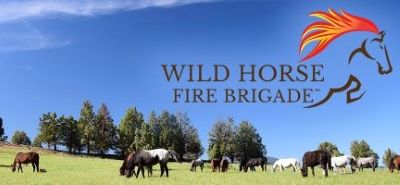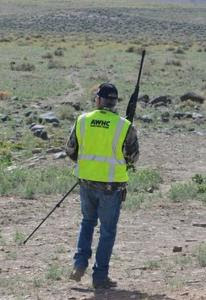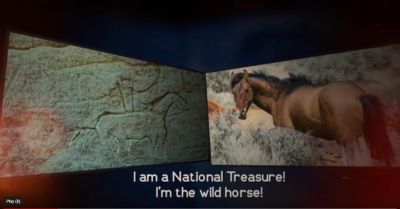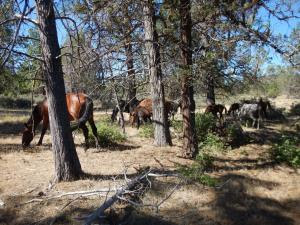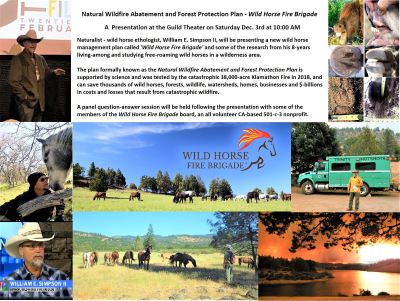William E. Simpson II is greeted by a wild mountain stallion in the Soda Mountain Wilderness area.
YREKA, CA, US, December 22, 2022 /EINPresswire.com/ — The assumption that the ‘1971 Free Roaming Wild Horse and Burro Protection Act’ (‘1971 Act’) is protecting American wild horses today is incorrect.
It’s a fact that over the past 50+ years since the 1971 Act was passed, socioeconomic impacts on land management policies driven by consumerism have resulted in the highly flawed, inhumane management of wild horses witnessed today.
Like flies to any dying or dead animal, the ineffective and failing wild horse management program was quickly surrounded by money motivated people and wild horse nonprofit organizations who proffer numerous costly band-aids, which arguably benefit them far more than the wild horses.
Instead of learning from mistakes and implementing a genuine management solution that is most beneficial for wild horses, the band-aids that are promoted are highly flawed and conflict with the highest and best interests of the so called ‘protected’ wild horses.
Core Flaw in Wild Horse Management Today:
The core flaw in wild horse management program today is that managers are keeping wild horses in areas commingled with livestock, where for the past 200 years, apex predators have been eliminated with great prejudice to reduce losses of livestock.
During the 1800s many wild horses were relocated from their natural habitats into other regions via livestock traders.
When the 1971 Act was passed, many areas that had been used for livestock production for two centuries and largely devoid of apex predators became Herd Areas and Herd Management Areas (‘HMAs’). The result is that the wild horses contained in these HMAs are living in the absence of their co-evolved natural predators, which over the millennia had regulated wild horse populations and engaged in a process known as ‘Natural Selection’ that preserved the genetic vigor of the species. The result is that wild horse populations go unchecked and their genetics suffer from a lack of Natural Selection, both of which are bad for the sustainable conservation of wild horses.
It’s critical to understand that the process of Natural Selection works perfectly and weeds out weak genetics. Natural Selection works on many levels. For instance, having a large selection (diverse genetic representation) of bachelor stallions competing for breeding rights helps assure that the best genetics are represented in the competition and then carried forward by the champion who becomes a band stallion.
There is also a recently discovered more subtle form of competition representing another facet of Natural Selection, which occurs within in harems (mares) of family bands for the position of ‘lead mare’.
During 8 years living among and studying free roaming wild horses in an ecologically balanced wilderness, wild horse ethologist William E. Simpson II has discovered and recorded that the offspring of a lead mare has a survival advantage over the offspring of lesser mares in the band harem. This is because the band stallion and harem will stick with the lead mare, and the lead mare will wait as long as it takes for her new foal to gain its strength to travel with the band.
On the other hand, an omega mare who has a new foal that requires time to stand and be ready to travel with the family band may be faced with a difficult decision. If the lead mare moves the band before the omega mare’s foal is ready to travel, the omega mare will have to decide to stay behind with her foal, or abandon the foal and leave with the band. Either way, the omega mare’s foal has a lower rate of survival without the protection of the band and its stallion.
Examining flawed band-aids being applied to failed management:
1) Roundups and subsequent warehousing of captured wild horses into off-range feed lots are argued as one manner of managing wild horse populations in areas devoid of apex predators. These methods are very costly for taxpayers (>$150M/year) due to lots of personnel, equipment, aircraft, feeding horses hay, etc., and they are brutal, inhumane, and ecologically inappropriate given that such actions do not correct the core problem.
Roundups also result in ecological damage to landscapes due to stampedes, where dozens of wild horses running for their very lives from helicopters trample the landscape, injuring and killing some flora and fauna. During helicopter roundups, wild horses are run for miles and beyond their natural ability, adversely impacting the health of horses. Pregnant mares spontaneously abort foals on the run, and new foals run their soft new hooves off and go lame and fall behind, ending up being eaten alive by coyotes.
2) So-called ‘contraception’ (costing tens of millions annually) is a nice sounding term for what is actually ‘chemical sterilization’ of mares using chemicals commonly known as ‘PZP’ and ‘GonaCon’, along with the castration of stallions. PZP and GonaCon are known to adversely impact the social structure and hierarchy of the harem, where lead mares that sterilized can lose their status in the band.
One program known as ‘Veterans for Mustangs’, and the bill by the same name (H.R.7631 — 117th Congress, 2021-2022), proposes to have military veterans using high powered gas operated rifles to shoot heavy darts/projectiles containing chemical sterilization compounds into wild horses, making a complete mockery of the intent of the 1971 Act, by stalking and shooting wild horses (a.k.a. ‘harassment’), like at a carnival shooting gallery.
The wild horse nonprofit known as American Wild Horse Campaign also engages in this ludicrous and dangerous activity. Studies show horses shot in this manner can suffer from bleeding, hematoma, broken bones, and death.
More on ‘PZP’ and ‘GonaCon’: https://www.einpresswire.com/article/553542481/decimation of wild horses continues path forward plan supported by non profit activist organization return to freedom.
“Fertility control in free‐roaming wildlife populations has been associated with changes in immigration (Ramsey 2005; Merrill, Cooch & Curtis 2006), decreased group fidelity (Nuñez et al. 2009; Madosky et al. 2010), increased survival (Caughley, Pech & Grice 1992; Kirkpatrick & Turner 2007; Williams et al. 2007), altered reproductive behavior (Nuñez, Adelman & Rubenstein 2010; Ransom, Cade & Hobbs 2010), and shifted phenology (Ransom, Hobbs & Bruemmer 2013)” ~ Ecological feedbacks can reduce population‐level efficacy of wildlife fertility control.
The use of chemicals to control wild horse populations (wildlife) disintermediates evolutionary Natural Selection and leads to genetic erosion and social disruptions in wild horses (equids). Furthermore, using chemicals (PZP & GonaCon) is ‘Selective Breeding’ and leads to genetic decline.
MORE: https://www.einnews.com/pr_news/550887360/wild horses wild horse management non profit organizations wrong chemical use on wildlife populations flawed
In addition to the social breakdown of family bands, genetic erosion, and selective breeding that are all part of using PZP on free roaming native species American wild horses, we also find evidence of the following:
“Even on a large animal struck correctly, the dart (contraceptive PZP and GonaCon darts) can cause hemorrhage and hematoma. Misplaced shots can break bones or even kill the animal” (Thomas and Marburger 1964). Muzzle report can cause problems in darting either captive or free ranging animals. In captive situations, the noise can be more disturbing to animals than getting struck with a dart. Disturbed animals are then more difficult to approach, or the entire group of animals may run away” ~ Page 32, Overview of Delivery Systems for the Administration of Contraceptive to Wildlife”, by Terry J. Kreeger.
3) Farming out wild horses at taxpayer expense as so-called adoptable or trainable horses also costs American taxpayers, since the BLM pays $1,000 for each horse adopted.
As most wild horse advocates know, the 1971 act was passed to ostensibly protect wild horses, yet few parts of 1971 Act are being observed and followed by the Bureau of Land Management (‘BLM’) today.
Even the core intentions of the 1971 Act that are cited in its preamble are disrespected and ignored in the management of wild horses today by the very agency charged with protecting wild horses, the BLM. This is clearly the result of political pressures brought to bear on law and policy makers by the trillion-dollar corporations who provide campaign donations to politicians on both sides of aisle.
The key sentence in the preamble to the 1971 Act states:
“It is the policy of Congress that wild free roaming horses and burros shall be protected from capture, branding harassment, or death…”
The reality of life for wild horses in American today under the 1971 Act is quite different than what any outsider looking in would believe having read the 1971 Act.
The reality today, over fifty years since the passing of the 1971 Act, is that the BLM does everything to wild horses that was originally prohibited under the 1971 Act.
The BLM regularly and aggressively; captures, brands, and separates family members from each other, where stallions, mares, and juveniles are sent into separate holding corrals even as family members scream for each other, causing tremendous emotional hardship for wild horse families. After segregating horses by sex and age, they are genetically molested where stallions are castrated and mares are chemically sterilized. This inhumanity transcends the prohibited ‘harassment’ cited in the 1971 Act.
It’s a horrifically brutal and inhumane scene that is repeated annually dozens of times each year in America over the past 40 years.
The protests of wild horse advocates and wild horse nonprofits, in court and in the media, have yielded no change in the behavior of the BLM.
That’s simply because the public servants at Government agencies are like soldiers carrying out the orders that are handed down from their superiors, who are essentially controlled by elected politicians who in turn are arguably beholden and influenced by campaign contributions from huge corporations.
A very simple example of the foregoing is relevant to the current SAFE ACT (H.R. 3355) that is languishing in the U.S. Senate.
The lawyers who drafted the Safe Act made sure there was a loophole for a major corporation (Nestle’) who owns the second largest pet food company in Mexico Purina (conveniently located just over the U.S. border in Mexico). In order to remain profitable, Purina requires a constant source of horse meat from America and elsewhere.
A review of the last draft of the SAFE Act showed that shipments of American horses for ‘human consumption’ outside the U.S. would be prohibited if the act passed. However, there is an arguable loophole: shipments of American horses for ‘animal products’ is not cited as being prohibited in the draft bill.
Since the installment of Deb Haaland as the head of the Department of Interior (‘DOI’), which oversees the BLM, the brutal process of rounding up wild horse families in holocaust fashion have increased.
Wild Horses captured by the BLM and the United States Forest Service (‘USFS’) are then genetically molested where stallions are castrated and mares are sterilized using chemicals commonly known as ‘PZP’ and ‘Gonacon’. These chemicals are known ‘genetic poisons’ and end the natural life cycles and genetic lines of wild horses.
No DNA (genetic) testing is performed by the BLM or USFS prior to ending gene lines of processed wild horses using castration or chemical sterilization.
This practice is a form of ‘selective breeding’, and as science proves, ensures a loss of genetic diversity, resulting in genetic decline in wild horse herds, and ultimately leads to ‘bottle necking’ and possible extinction of wild horse gene lines, which contain the most robust equine genetics.
At some point soon, domestic horse breeders will need to breed back to these robust genetic lines to reinvigorate domestic horse breeds, many of which are suffering from congenital defects and genetic diseases related to inbreeding over centuries.
Following this initial horror show, wild horses are then processed for allocation into so called programs that are extremely costly to American taxpayers, and further punish wild horses emotionally.
The BLM sells it Adoption Incentive Program (‘AIP’) as a success and solution for getting rid of wild horses they have rounded up. However, combination of the AIP and other wild horse processing programs (prisoner programs, etc.) only places a small percentage of all the wild horses (about 5-7%) rounded up into the hands of adopters or trainers who are paid $1,000 (tax dollars) by the BLM for each horse adopted.
Wild horses that are funneled into adoption and training programs are wild sentient beings, few or which will submit to any training program.
Wild horses adopted are made to submit to the demands of human trainers. Surprisingly, so-called horse ‘trainers’ fail to understand the wild nature and spirit of wild horses, as opposed to domestic horse breeds, which have been bred for the past 6,000 years to serve the utility of humankind and are well suited to training. This failure by people and trainers to understand wild horses and their behavioral ecology leads to a majority of wild horses placed in programs resisting training and ending up at slaughter auctions for meat in the pet food industry, a horrific ending for innocent wild horses.
The Big Question: Is there a better solution to the current wild horse management debacle?
Answer: Absolutely!
There is a plan that provides a more humane, natural, and cost-effective management paradigm for wild horses.
That plan is called the ‘Natural Wildfire Abatement and Forest Protection Plan’, also known as the ‘Wild Horse Fire Brigade’.
Wild Horse Fire Brigade is a cost-effective solution for humanely managing wild horses naturally without keeping them on degraded ecologically collapsed landscapes that are being intensively used for commercial enterprises, including oil, gas, mineral, and livestock production.
Keeping wild horses in areas where they are deemed to be in conflict with the interests of $Trillion/year corporations guarantees that wild horses will remain in a constant state of conflict with consumer driven demands for public land use, resulting in the highly flawed and costly management concepts previously cited.
2022 MUSTANG SUMMIT presentation on Wild Horses and Consumerism on YouTube:
https://www.youtube.com/watch?v=s3pCv0VgMOI
What many people (including some wild horse advocates) fail to realize is that there are 115 million acres of designated critical wilderness where motorized vehicles and livestock production are prohibited due to law and costly logistics.
Using just 20 million acres of this vast water and forage rich wilderness area, up to 100,000 wild horses could be redistributed (rewilded/relocated) as family bands, at the rate of 1 horse per 200 acres, away from conflicts, ending the plight of wild horses.
This plan provides wild horses with habitat that is consistent with what they had enjoyed prior to the arrival of the Europeans in north America. Wild horses are completely at home in the deep wilderness and had survived in such habitats for 1.7 million years in North America.
And via reestablishing wild horses into economically and ecologically appropriate wilderness areas, these keystone herbivores can once again re-balance ecosystems, and manage the now over abundant grass and brush wildfire fuels. This natural symbiotic wildfire grazing reduces fuel loading and results in normalizing the wildfire regime, devolving super fueled super-hot catastrophic wildfires back into the normal wildfire expected on the landscape that burns low, slow, and cooler as a result of less fuel. This in turn saves forests, wildlife, and watersheds from catastrophically hot wildfires.
LEARN MORE:
More about the many benefits of the Wild Horse Fire Brigade plan HERE: https://www.wildhorsefirebrigade.org/_files/ugd/b50928_b546b19ef08441349993b0d3fd8111eb.pdf
ReWilding Europe’s wildfire focused journal ‘GrazeLIFE’ published an abstract of the Study that supports the Wild Horse Fire Brigade plan online at:
https://grazelife.com/blog/wild horse fire brigade lessons in rebalancing north american ecosystems by rewilding equids/
NPR has also published a story (with audio) online at:
https://www.npr.org/2022/10/30/1131042723/preventing wildfire with the wild horse fire brigade
Please visit www.wildhorsefirebrigade.org for more information.
